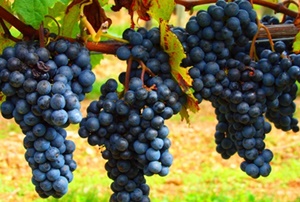Scientists at the Agharkar Research Institute (ARI), Pune, an autonomous institute of the Department of Science and Technology (DST), have developed a hybrid grape variety which is resistant to fungal diseases, high yielding and has excellent juice quality. It is also suitable for preparation of juice, raisin, jam and red wine and farmers are enthusiastically adopting the variety, says a DST release.
- The hybrid variety ARI-516 has been developed by interbreeding of two species from the same genus -- Catawba variety of Vitis labrusca and Beauty seedless variety of Vitis vinifera
- The hybrid variety ARI-516 has been developed by interbreeding of two species from the same genus - Catawba variety of Vitis labrusca and Beauty seedless variety of Vitis vinifera. Maharashtra Association for the Cultivation of Science (MACS) and ARCI has actively collaborated in developing the new grape variety, which will benefit farmers, the processing industry and consumers, according to the DST.
- The work has been published in the in Proceedings of the International Symposium on Grape Production and Processing.
- Sujata Tetali, Scientist, Genetics and Plant Breeding Group from MACS-ARI, has developed this inter-specific variety by working on necessary properties. The fungal resistance of ARI-516 has been derived from Catawba, which is an American grape variety. It has superior quality fruits and higher yield per unit area. An early ripening hybrid, it matures in 110 - 120 days after pruning. The variety has elongated bunches and bears pleasant musky flavoured berries and performs well in Maharashtra, Telangana, Tamil Nadu, Punjab and West Bengal.
- MACS-ARI is involved in the Indian Council of Agricultural Research (ICAR's) grape improvement programme through All India Coordinated Research Project on Fruits. MACS-ARI has developed many inter-specific and intra-specific grape hybrids under the hybridisation programme. The hybrids are evaluated for their disease resistance, fruit quality, and whether they are seedless or not.
- India ranks twelfth in the world in terms of grape production. About 78 per cent of grape production in India is utilised for consumption, 17-20 per cent for raisin production, 1.5 per cent for wine and 0.5 per cent for juice. Maharashtra leads in the production of grapes in India with a share of 81.22 per cent. A negligible share of grapes is used for juice production.
- A majority of farmers in Maharashtra cultivate 'Thompson seedless' and its clones for table purpose or raisin making. These varieties are highly susceptible to fungal diseases which increase plant protection cost. Grapes suffer 8.23-16 per cent of post-harvest losses. Juice making is an excellent option to reduce post-harvest losses.
- ARI-516 grape variety has been recently identified for release by the Varietal Identification Committee of ICAR-All India Co-Ordinated Research Project on Fruit, for cultivation in Maharashtra, Punjab, Telangana and Tamil Nadu.
- The salient features of ARI-516 include evenly maturing character with long cylindrical medium-sized fruit bunches making this variety superior over other varieties. It has small to medium bluish blackberries with one rudimentary seed in each berry, which is sweet in taste having the value of TSS (Total Soluble Solids) as 20-22 0B with musky flavor having about 65-70 per cent juice content. The berry yield is about 15-20 tonnes per acre, and it is tolerant to downy and powdery mildew diseases as well as resistant to anthracnose disease - a group of fungal diseases that affect a variety of plants in warm, humid areas.
- The consumers prefer ARI-516 for its unique flavour. Being moderately resistant to a majority of fungal diseases, its cost of production is lower. The area under cultivation of ARI-516 is steadily growing and has reached 100 acres. Source: https://www.domain-b.com/


